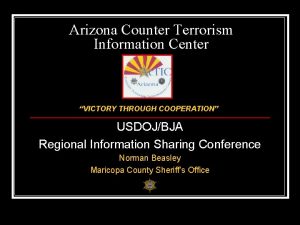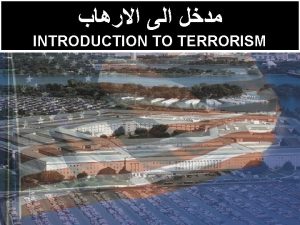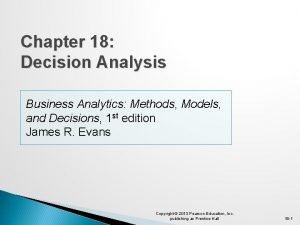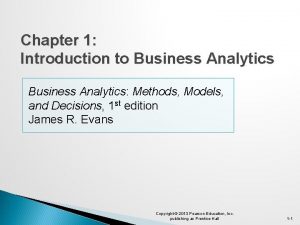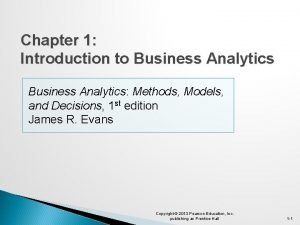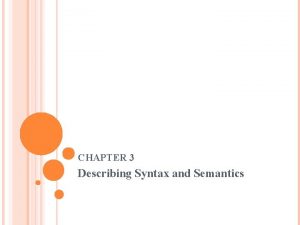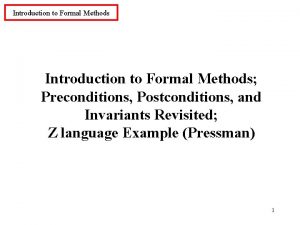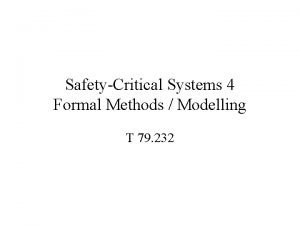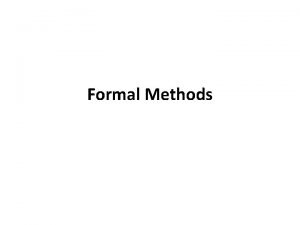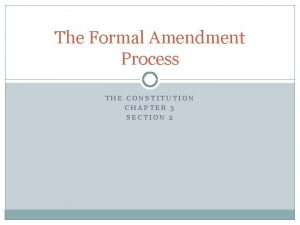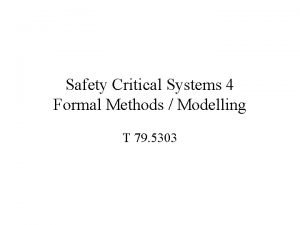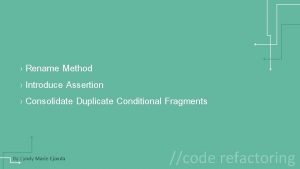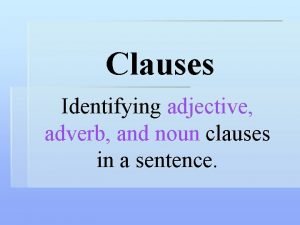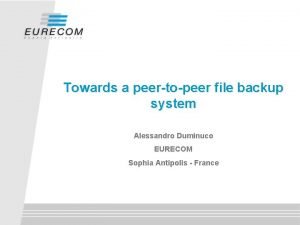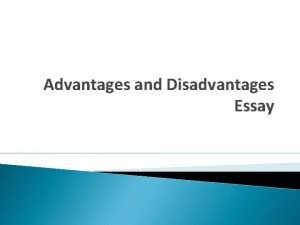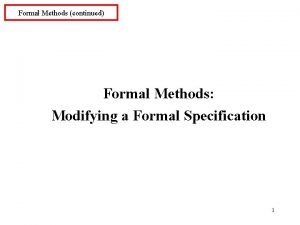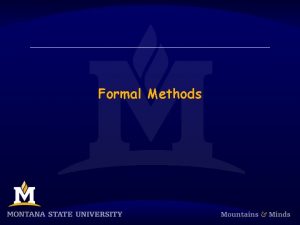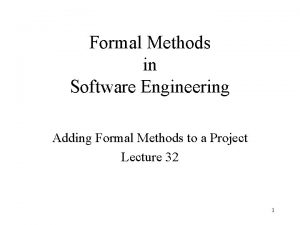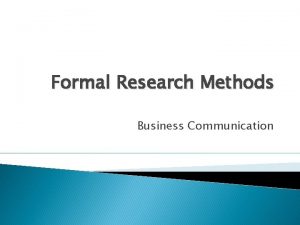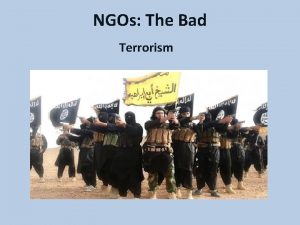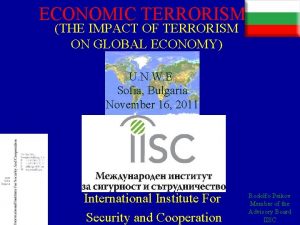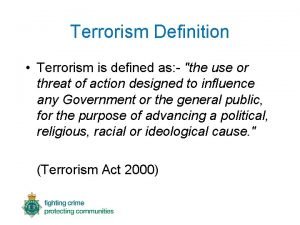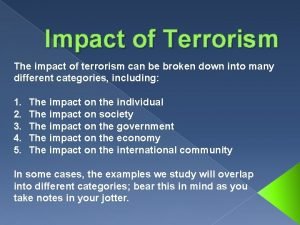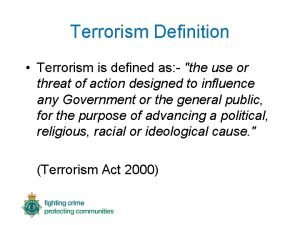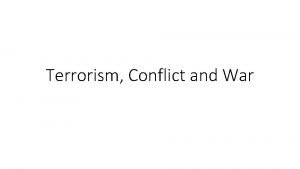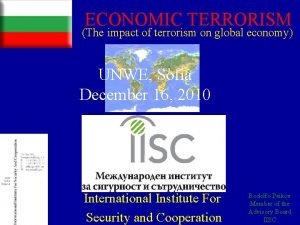Formal Models of Terrorism 1 Introduce formal methods








































- Slides: 40

Formal Models of Terrorism 1. Introduce formal methods and show they apply to studies of terrorism. 2. Present examples from current research. 3. Discuss further research ideas using game theoretic studies of terrorism. 4. Discuss the strengths and weaknesses of this approach.

Understanding a Complex World § The world is very difficult to understand – complex, noisy. § Think about your reaction to 9/11. § Almost immediately, people develop quick explanations to help them understand. § All of these explanations are essentially “models. ”

Why Formalize? § Mathematical reasoning attempts to, as best as possible, remove emotional responses and be precise in our definitions. § The mathematics is simply a reflection of the model’s logic – and using math is a way of determining what conclusions flow from the assumptions you make. § Formal models attempt to make an argument logically transparent – all of the assumptions are identified – and conclusions must flow from the assumptions.

Example of Informal Arguments Gone Bad… n Suppose I want to devise an argument to hold the Taliban accountable for supporting al Qaeda. n Assumption: States have monopoly on the legitimate use of force. n Implication: State support for any violent non-state actor, including terrorists, violates international law. n Conclusion: Therefore, by hosting al Qaeda, the Taliban violated international law.

But, my argument has a hidden implication… n The U. S. is also guilty!!! n U. S. hiring of Blackwater violates international law. n U. S. support for Northern Alliance and Iraqi National Congress also in violation. n Formalizing arguments and making them explicit often exposes these sometimes unintended implications, or at least makes them transparent.

A Second Reason: Unobservables • Important to examine data to observe patterns. • But, very important to develop theoretical explanations. • Not enough to answer what is going on, it’s also important to know why. • Especially because sometimes observations can be deceiving, particularly in an area like terrorism.

Example: Ku Klux Klan Attacks Borrowed from Freakonomics

What’s Going On? • When Klan is weak, it lynches to appear powerful. • If Klan is established, no one challenges it, so lynchings fall. • Similar pattern in al Qaeda in Iraq’s level of violence today. • Using formal models allow us to understand what we’re observing, but also what we’re not observing.

Rational Choice Models 1. Do not judge the morality of action. 2. Assumption that people have free will. 3. Individuals choose actions to achieve their goals: attempt to “maximize utility. ” 4. Understanding that reality is simplified.

Rational Choice Models n According to rational choice, rationality means you have ordered, transitive preferences. n Example: Tenure > Join Blackwater > Unemployment n Tenure > Blackwater > Unemployment Tenure > Unemployment n Given my laughable shooting skills, everyone would be better off if I got tenure!

Same with Application to Terrorism: Zarqawi’s Preferences 1. Kill Americans. 2. Kill Shi’ites. 3. Kill Sunni collaborators. Preferences are clearly homicidal, and appear crazy. Doesn’t matter, as long as they are ordered and transitive, Zarqawi can be considered rational.

The Challenge: Making Decisions Under Risk n Now you need to make decisions to realize these outcomes. The problem, however, is that you don’t have perfect foresight. n In almost all aspects of international politics, individuals make decisions under risk. n Example: If you attack Afghanistan, you have a 60% chance of killing or capturing bin Laden. n To be rational, you make decisions by assigning utilities (numerical values) to outcomes and incorporate risk.

Bush Preference Profile Kill bin Laden > Bombing Campaign > Fail to Capture bin Laden 1 0 -1 n If Bush invades Afghanistan, he has a 60% chance of killing bin Laden and getting a value of 1. n But, there is also a 40% chance that the operation will fail, resulting in a value of -1. n If he only engages in a bombing campaign, he won’t capture bin Laden, but he won’t fail. He therefore gets a value of 0 for certain.

Expected Utility Calculation EUBUSH(Invasion) = (. 6)*(1) + (. 4)*(-1) =. 2 EUBUSH (Bombing Campaign Only) = 0 Since. 2 > 0, Rational G. W. attacks.

Understanding Strategic Interaction n Game Theory is the study of strategic interaction among rational individuals. n If I think you are going to attack, how does this affect my decision-making? n If we know Bush will attack, how does this affect bin Laden’s decision?

9/11 Game: Bin Laden and Bush Attack Do Not Attack Bin Laden: 0; Bush: 1 Bush Invades Bush Bombs Bin Laden: 1; Bush: 0 Capture bin Laden 60% Bin Laden: -1; Bush: 1 Miss bin Laden 40% Bin Laden: 2; Bush: -1

What Does Bin Laden Do, Given Bush’s Actions? n We know from the previous calculation that Bush will invade. n Bin Laden can therefore anticipate an American invasion in response to his attack. n n So, EUBINLADEN (Attack) =. 6*(-1) +. 4*(2) =. 2 Compare to EUBINLADEN(No Attack) = 0 n Since. 2 > 0, bin Laden Attacks.

What do the Numbers Mean? n The “numbers” can be seen as variables. n For example, let us consider p, or the probability of victory. n The value of p is a function of the U. S. investment in its military and counterinsurgency capability. n This is public information, bin Laden can get it!!! n Since p is a probability, U. S. kills bin Laden with probability p and fails to do so with probability (1 -p).

9/11 Game: Bin Laden and Bush Attack Do Not Attack Bin Laden: 0; Bush: 1 Bush Bombs Bush Invades Bin Laden: 1; Bush: 0 U. S. Wins p Bin Laden: -1; Bush: 1 U. S. Loses 1 -p Bin Laden: 2; Bush: -1

The Model in Strategic Form Bush Invade Attack p(-1)+. (1 -p)(2); Bin Laden ~Attack Bomb 1 p(1)+(1 -p)(-1) 0 0 0 1 1 Equilibrium: A set of rational best replies. We now logically prove when 9/11 occurs, given the value of p.

Equilibrium Bush Invade Attack p(-1)+. (1 -p)(2); Bin Laden ~Attack Bomb 1 p(1)+(1 -p)(-1) 0 0 0 1 Bin Laden’s equilibrium strategy is to attack if p < 2/3. Bush’s equilibrium strategy is to attack if p > 1/2. 1

Why is this Useful? n This was a very simple model, but we still learned something. n Game theory often does illustrate conclusions that conventional wisdom has already uncovered. n But, game theory frequently also leads to conclusions that are not necessarily obvious. n If the assumptions that led to the obvious conclusions are correct, then the non-obvious conclusions should also be correct.

Application #1: Counter-terrorism § Problems with U. S. counterterrorism spending are well documented. § Terrorists can observe this, and therefore probably think it’s a good idea to attack cities. § But, if this is true, why has there not been another 9/11 style attack?

Application #1: Counter-terrorism § Public information says city security may be inadequate, while pork is being spent on other areas. § But, appropriations for security done in previous fiscal years, meaning that city security is already upgraded. § If terrorists think the facilities are unprotected, they will still attack – and they will be caught!

Application #1: Counter-terrorism § This mixing of signals maximizes protection with a limited budget. § Unfortunately, at some point, terrorists will adjust their strategies. § Therefore, a key part of counter -terrorism is mixing signals to minimize these successful attacks – game theory can tell you how.

Application #2: Peace Processes § Both governments and terrorists claim to want peace – but peace processes are rare. § Often times – they keep fighting, even though there appears to be no end in sight. § Why does this occur? § Bargaining theory identifies what is known as a commitment problem.

Application #2: Peace Processes Arafat Fulfill Renege 5 Barak 0 5 Renege 10 10 0 Both sides prefer fulfilling their agreement to watching the agreement fail, but…

Application #2: Peace Processes Arafat Fulfill Renege 5 Barak -1 5 Renege 10 10 0 -1 0 Since both sides fear that the other will renege, both sides have incentives to renege!! So, there is no peace agreement!

Application #3: State Sponsorship n One of my main areas of interest is state sponsorship of terrorism. n From Bruce Hoffman, Daniel Byman, and others, we know that this often ends badly for the sponsor. n Sponsor might want to make peace, but terrorists want to keep fighting. n Lots of examples: US & mujahedeen; India & LTTE; Pakistan & Kashmiris.

Puzzle of State Sponsorship n But, if we know that sponsorship often ends badly, so should the sponsor. n So, why would a sponsor support a terrorists if it knew that doing so would eventually be costly? n If we follow the logic, the empirical expectation is that we should not observe state supported terrorism. n But, the puzzle is that we still do…why?

We can address this using a Model

Uncertainty n Host is unaware of the target’s payoff for attacking – it cannot perfectly predict if the target will escalate in its final move. n If the host opposes the militants, it faces the risk of destabilization (γ). n The host holds onto power with probability γ, and loses power with probability (1 - γ). n However, if a deal is reached, the target provides aid to the host such that the value of γ increases.

Model Interpretation: Support for Hoffman and Byman n Catalyst for war is often sponsors that lose control over their terrorists. n Weak states cannot credibly agree to disarm their terrorists. n If target is credible and sponsor cannot control its terrorists, conflict spreads into war. n Empirical examples: Taliban & al Qaeda; Lebanon & PLO; Laurent Kabila & interhamwe.

But, Something New… n What if the target cannot credibly threaten an attack? Then, target has no choice but to bargain. n If the sponsor appears vulnerable, the sponsor is going to demand enormous concessions. n In other words, the weaker the sponsor appears, the more the sponsor gains!!! n This is why states support terrorism, even if there is some probability that it will backfire.

Pakistan n Despite all evidence to the contrary, Pakistan is considered a loyal ally in War on Terror. n The reason is that Bush prefers keeping Musharraf in power than allowing Pakistan to collapse. n Result: sponsorship is profitable for Musharraf!!!

Saudi Arabia n According to many in U. S. government, Saudi Arabia does not appear fully cooperative. n But, Bush Administration insists that Saudi Arabia is a loyal ally. n Why? A Saudi collapse would be devastating for the U. S. n If the target cannot credibly attack, host states have incentives to appear as weak as possible!!!

What did the Model Teach Us? n We see the traditional argument, but we also learn something new… n If it appears that the sponsor will lose control, and the target prefers keeping the sponsor in power… n Therefore, even if there is a risk that terrorists will turn on them later, support for terrorism can provide bargaining power.

Game Theory and Questions of Terrorism 1. How do terrorists mobilize? 2. How do terrorists design their organizations? 3. When and where do terrorists attack? 4. What are the optimal counter-terrorism policies states can adopt?

Game Theory and Questions of Terrorism 5. When should states negotiate with terrorists, and when are such negotiations successful? 6. When do terrorists move abroad in search of international alliances? 7. How does terrorism spread to international war? 8. How can states design institutions to minimize terrorism?

Shortcomings of Rational Choice n Not descriptively accurate – nobody actually calculates stuff. n Assumes away preferences, therefore cannot answer very important question such as why terrorists have the preferences that they do. n Models can either be too simple or overly complex. n But, despite these limitations, I believe this method is very effective, particularly when tested empirically.
 Arizona counter terrorism information center
Arizona counter terrorism information center Terrorism
Terrorism Liberals vs conservatives apush
Liberals vs conservatives apush Terrorist
Terrorist Nato definition terrorism
Nato definition terrorism Terrorism definition
Terrorism definition What is the difference between models & semi modals?
What is the difference between models & semi modals? An introduction to variational methods for graphical models
An introduction to variational methods for graphical models The engineering design of systems: models and methods
The engineering design of systems: models and methods Business analytics methods models and decisions
Business analytics methods models and decisions Scope of business analytics
Scope of business analytics Business analytics methods models and decisions
Business analytics methods models and decisions Chapter 7 linear programming solutions
Chapter 7 linear programming solutions Wax pattern in fpd
Wax pattern in fpd General problem of describing semantics in ppl
General problem of describing semantics in ppl Z notation in software engineering
Z notation in software engineering Formal methods
Formal methods Types of formal methods
Types of formal methods Formal amendment definition
Formal amendment definition Formal methods
Formal methods Introduce assertion
Introduce assertion Signal phrase definition
Signal phrase definition Let me introduce my family
Let me introduce my family Introduce yourself
Introduce yourself Restrictive adjective clause examples
Restrictive adjective clause examples Advantage and disadvantage essay sample
Advantage and disadvantage essay sample Phrase vs clause
Phrase vs clause Sentence starters for quotes
Sentence starters for quotes Let me introduce myself music
Let me introduce myself music How to introduce yourself in class 11
How to introduce yourself in class 11 Linux to introduce driver just to
Linux to introduce driver just to Analytical paragraph writing examples
Analytical paragraph writing examples Introduce family members
Introduce family members To introduce new just to deal
To introduce new just to deal Prayer for school opening
Prayer for school opening Let me introduce myself my name is
Let me introduce myself my name is To ensure that conscious marketing
To ensure that conscious marketing Phrases to introduce advantages and disadvantages
Phrases to introduce advantages and disadvantages Introduce parts of a medical term
Introduce parts of a medical term Example of a shocking statement
Example of a shocking statement Proposizioni subordinate tabella
Proposizioni subordinate tabella
